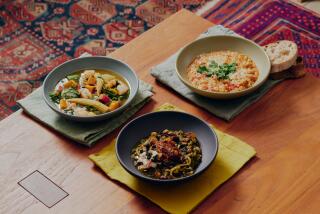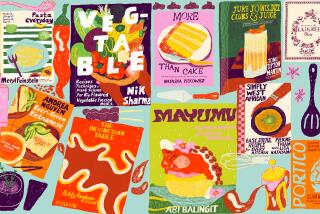Midsummer madness
- Share via
ONE particularly sauna-ish day a friend mentions he is eating nothing but raw food right now because turning on the stove just feels like too much effort. It sounds a bit extreme, but he could be even more uninspired. He could be doing nothing but grilling.
Hot weather combined with perfect produce seems to make most cooks stow away technique for the summer. Everything is so good simply washed or charred that it’s easy to slip into a robotic routine, shuffling between the salad spinner and the Weber.
But an amazing thing happens when you apply cooking methods more common in other seasons, or for other reasons, to the best ingredients these peak months have to offer. Flavors get more intense, textures are transformed and the element of surprise becomes a secret ingredient at a time when excess-induced ennui is setting in with even the sweetest corn and most succulent berries.
Braising, for instance, is what you normally do with tough cuts of meat that need long, slow cooking in other months of the year. But at the height of summer it can be the best method of quickly infusing deep flavor in vegetables or even fruit, whether green beans or cherries.
Stewing is another technique that conjures hours-long investments in meat, but in summer it works fast on stone fruit and berries in a compote, or on zucchini and tomatoes in a side dish (or main course when you add eggplant and onion to make ratatouille).
Then there is pickling, an ancient summer concept, traditionally done to save time in a bottle in a world before refrigerators. Cucumbers or peaches or carrots could be canned and stored on a shelf for the long months of winter. Today, an inconvenient truth is that we can have anything anytime and don’t need to pickle except for flavor reasons.
Quick pickling brings acidity and crispness into the equation, literally transforming vegetables (and fruits) that are starting to feel boring cooked any other way. When you try it, even okra tastes irresistible.
Back to basics
I first started going back to these basics earlier this summer after laying the 15th bunch of asparagus out on the counter and realizing I could not face it steamed or roasted one more time. When I opened my refrigerator door looking for inspiration, one of the six bottles of flavored oils and nut oils fell forward and I realized they might have more impact if added at the beginning of cooking rather than at the end.
And that made me think of braising (technically, it means searing something in fat, then adding a nominal amount of liquid and cooking to tenderness). Just a tablespoon of pistachio oil heated in a saute pan and tossed with a bunch of asparagus tips and a good sprinkling of coarse sea salt imparted a deep underlying flavor. I could have continued by sauteing, but the high heat would have dissipated the lovely nuttiness of the oil.
Instead, I poured in a little water, covered the pan and let the spears cook until they were just tender, then took off the lid and left them to almost char. When they were done, they had a warm undertone of pistachio and no grease and needed nothing except a little pepper to be perfect.
Quick braising, though, is a superb technique for most summer vegetables. You could add a whole stick of melted butter to a bowlful of steamed sugar snap peas or zucchini or green beans and never get the full, rich, inherent flavor achieved by braising in just a whisper of nut oil.
Corn and chanterelles are two great seasonal highs that combined will always be transcendent, but braise them and they are both transformed. (Ditto for corn and Swiss chard.)
You can also braise some surprising other things, such as scallions or sliced (and seeded) cucumbers, and make them even richer by stirring in a little cream or sour cream at the end. Favas are also superbly suited to braising, which concentrates their nutty taste.
Braising will also soften and concentrate the flavor of fruit if you substitute unsalted butter for the oil, and a fruity wine, brandy or liqueur for the water. Braised peaches, mangos, apricots, plums or cherries are all great possibilities, almost melting with sweetness with or without ice cream.
Stewing is even better for fruit because it involves more liquid than braising does, and with sugar and spices and the inherent juices forms a thin sauce that will ooze into a poundcake or onto ice cream or even fresh ricotta, the greatest companion for warm summer fruit since creme fraiche.
A sweet stew
TO make a compote, which is the fancy way of saying fruit stew, you just boil sugar and water until the sugar dissolves, then add the fruit of your choice. Flavorings such as a cinnamon stick, whole allspice berries or cloves, fresh ginger or strips of lime or lemon zest can infuse the syrup, and alcohol increases the potency and gives body (rum, Bourbon, kirsch and framboise are possibilities, depending on the main ingredient).
But then stewing is a much-overlooked technique for summer vegetables in an al dente world. Zucchini and other summer squash are spectacular grilled, steamed, roasted or even raw, but stewing, especially with tomatoes, changes their character completely.
Essentially they melt into whatever else is in the pot to produce new flavors and sensations in your mouth.
Corn is excellent stewed (especially with cream), but so are onions, green onions, peppers and eggplant.
Pickling is too easily overlooked, burdened with an image as a technique you would never try at home anymore because it involves canning and great quantities and huge chunks of time to produce vegetables that will winter over.
But you can do it quickly with quantities for almost immediate gratification too: Just make a brine with a cup of vinegar cut with half a cup of water, a tablespoon of kosher salt, one-fourth cup of sugar and some spices of your choice, pour it over anything fresh from the farmers market and let the vegetables sit overnight.
Slimness is everything
CUCUMBERS are the obvious candidate, but pickling absolutely changes okra from a slimy reprobate into a tempting side dish in a matter of hours. (Use very young, very tender and very, very fresh pods to get the best results, though.)
It also works with very skinny green beans, very thinly sliced carrot sticks and especially thinly sliced red onions. The slimness of the vegetables is important for maximum exposure to the pickling liquid.
By varying the spices, which are typically dill seeds or mustard seeds, you can change the flavor profile even more. Star anise will give an Asian aspect, for instance, while cumin and coriander seeds evoke India.
In Mexican cooking, pickled vegetables -- especially zucchini and jicama -- are called en escabeche and often take on a smoky heat from chipotles.
As farmers markets pile up with more produce than you can eat right away, pickling is also a good stopgap method of dealing with overbuying.
Vegetables that would wilt in a matter of days will stay crisp in the refrigerator for a week or more once you transform them with one of the oldest techniques in the cookbooks.
*
Stewed fruit
Total time: About 15 minutes
Servings: 4
Note: Other fruit or berries can be substituted for the mango and blueberries, but the cooking time will vary (raspberries, for instance, should be added at the very end and not cooked). This can be served over ice cream or, for something completely different, fresh ricotta.
1 lime
1/4 cup sugar
4 allspice berries
1 tablespoon dark rum
1/2 teaspoon Angostura bitters
2 large, firm but ripe mangos, peeled and cut into 1-inch dice
1/2 pint fresh blueberries
1. Using a paring knife or vegetable peeler, cut the peel off the lime in thin strips, taking care to remove only the green and none of the bitter white. Place the strips in a medium saute pan and add the sugar and allspice berries. Add half a cup water and stir to blend. Bring to a boil, then reduce the heat and simmer 5 minutes.
2. Using a slotted spoon, remove and discard the lime zest and allspice berries. Stir in the rum, the bitters and 1 tablespoon of juice from the lime (reserve the remainder for another use). Simmer 30 seconds.
3. Lower the heat and gently stir in the fruit. Cook 5 to 7 minutes, until the fruit is heated through but not falling apart. Remove from the heat and let cool 5 minutes before serving.
Each serving: 160 calories; 1 gram protein; 38 grams carbohydrates; 3 grams fiber; 0 fat; 0 saturated fat; 0 cholesterol; 2.73 mg. sodium.
*
Braised corn with chanterelles
Total time: 15 minutes
Servings: 4
4 ounces chanterelles
1 tablespoon pistachio, hazelnut or walnut oil
2 cups fresh corn kernels (cut from 3 small ears)
3/4 teaspoon coarse sea salt
Freshly ground pepper to taste
1. Using a mushroom brush or a soft toothbrush, gently wipe any dirt off the chanterelles. If they are large, thinly slice the stems crosswise and the caps lengthwise. If they are small, just thinly slice the entire mushroom.
2. Heat the oil in a deep skillet over medium heat. Add the chanterelles and corn and stir in the salt with a rubber spatula. Cook 2 minutes, stirring constantly, until the corn and mushrooms are well coated. Stir in one-quarter cup water and cover the pan.
3. Cook 7 to 8 minutes, stirring occasionally, until the corn is tender. Uncover the pan and cook until almost all the liquid is evaporated. Season with pepper and serve.
Each serving: 103 calories; 3 grams protein; 16 grams carbohydrates; 2 grams fiber; 5 grams fat; 1 gram saturated fat; 0 cholesterol; 313 mg. sodium.
*
Pickled okra
Total time: 15 minutes, plus overnight pickling
Servings: 6
Note: This is best made with very fresh, very young, small okra pods. You can substitute 1/4 -by-2-inch carrot batons or very thin green beans.
1/2 pound fresh okra
1 cup white vinegar
1 1/2 tablespoons kosher salt
1/4 cup sugar
1 bay leaf
2 large cloves garlic, peeled and crushed
1 teaspoon mustard seeds
1/2 teaspoon chipotle or other hot red pepper flakes
1. Trim the stems off the okra without cutting into the flesh. Place in a glass bowl.
2. Combine the vinegar, salt, sugar, bay leaf, garlic, mustard seeds and chipotle in a small saucepan with one-half cup water and bring to a boil. Reduce the heat and simmer 10 minutes.
3. Strain the liquid through a sieve over the okra and stir. Let stand until the okra reaches room temperature, stirring occasionally. Cover and refrigerate overnight before draining and serving.
Each serving: 22 calories; 1 gram protein; 5 grams carbohydrates; 1 gram fiber; 0 fat; 0 saturated fat; 0 cholesterol; 468 mg. sodium.


